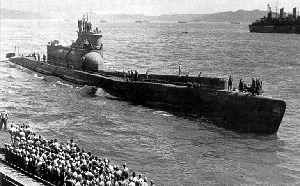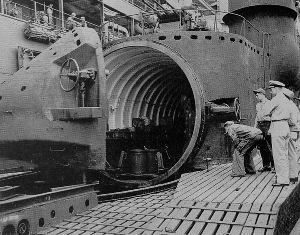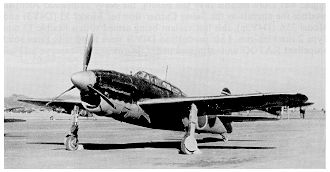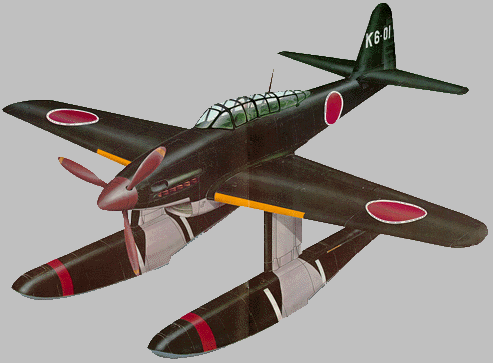By: Jim 'Twitch' Tittle
Date: 2005-03-29
The 140mm shells wailed into the oil field and began exploding around the storage tanks. The Pacific sun had gone leaving an afterglow to guide the deck gunners. The seventeen rounds did little or no damage but the action would announce that the I-17 had been there. They were the first fire upon America in WW II.
Commander Kozo Nishino’s boat was 4,000 miles from home off Santa Barbara, California when that incident occurred at 5:30 PM on February 25, 1942. I-17 was one 20 Type B-1 subs. 94 officers and men called her home during their missions. They could make 23.5 knots on the surface and 8 knots submerged. So big were the Type B-1s that they each carried a recon seaplane in watertight hangers. She was large at 365.5 feet in length displacing 3,654 tons submerged. Range was 14,000 nautical miles at 14 knots. Seventeen torpedoes were carried for the six forward tubes
Besides the futile flinging of shells into the dirt, I-17 scored by sinking two merchant ships as well during that voyage. Sister ship I-15 stole into the San Francisco’s waters and reconnoitered the area. Other boats sank cargo vessels and boldly made surface attacks in view of civilians on shore they were so close. There was no large scale concentration of lurking submarines on the west coasts as there was on the east coast with the U-boat threat and their torpedoing of many ships.
In September 1942 the I-25, another Type B-1, launched her floatplane which dropped two 110-lb. incendiary bombs in an Oregon forest causing little more than a nuisance. The Yokosuka E14Y1 (Glen) could only do 153MPH and had only a 7.7mm machine gun in the rear cockpit but it was an aerial attack on US soil.
Giants
The Sen-Toku class I-400 was built as the largest submarine class in the world in 1943 in Kure Navy Yard. This new class was designed to carry three two-seat Aichi M6A1 Seiran (Mountain Haze) floatplane torpedo-bombers capable of carrying either two 550-lb bombs or a 1,760-lb. torpedo at a range of 739 miles.

i400
During her construction the idea was born to use the Sen-Tokus to launch a surprise air attacks against the Panama Canal's Gatun Locks. The plan was to assign ten Seirans to strike the Locks with six torpedoes and four bombs. Destroying these locks would empty Gatun Lake and block the passage of shipping for months it was thought.
On December 30, 1944 when the I-400 was launched the attack on the Panama Canal had been shelved due to the large B-29 fire bomb raids on Tokyo. Revenge would now be had with an operation against San Francisco no less, putting I-15’s earlier recon to use. During the I-400’s construction several I-13 class boats were modified to carry two aircraft.
The Sen Toku class was large, being about half again as large as America fleet boats. The I-401 and I-402 followed. I-404 and I-405 were under construction at war’s end with the 404 being 90% complete. Thirteen more of the big boats were planned. They displaced 6,560 tons submerged and were 400 feet long. No submarine was larger until the American nuclear subs put to sea in the 1960s.
Four diesels with a combined power of 7,700 HP were augmented by four electrics with 2,400 combined horsepower for underwater activity. The big subs had snorkels in the style of U-boats too allowing use of the diesels while submerged. Surface speeds of 18.75 knots could be attained while 6.5 knots was maximum speed submerged. Fuel bunkers carried sufficient fuel for 37,500 nautical miles at 14 knots!
Maximum dive depth was shallow compared to U-boats at 330 feet. Ten 25 mm cannon served as AA weaponry while twenty 533mm torpedoes would launch from eight forward tubes. One 140mm deck gun was mounted. Crew compliment was 144 officers and men.

The Hangar
The three 38-foot long Seirans rode in a 115-foot cylindrical hanger nose to tail during transport to target area. Assembly was accomplished in just six minutes. The assembly crews were aided in low light conditions with fluorescent paint on key parts. Wingspan assembled measured 40 feet with normal weight at 9,370 lbs.
A catapult on the forward deck could launch the planes either with or without their floats. One way missions would require no floats. A 1,400 HP Atsuta 32 inverted V-12 liquid-cooled gave good performance. Top speed of the Seiran was 295 MPH at 17,060 feet with floats and 360 MPH without. The ceiling of 32,480 feet was rather high. It was close in performance and looks to the rugged Aichi D4Y dive bomber with the same power plant.

D4Y
Twenty M6A1s were made including several float-less trainers called the Nanzan (Southern Mountain) with retracting landing gear. Gun armament for all was a single 12.7 mm in the rear cockpit for defense.

The Seiran
The ever-changing course of the war saw the I-400 class boats attack plans change with it. No Panama Canal or San Francisco forays were attempted. The Ulithi Harbor at Truk Island was earmarked in an operation with I-401 plus I-13 and I-14 carrying their swift Nakajima C6N1 Saiun (Myrt) long range reconnaissance aircraft. The Myrts would recon the harbor and report to I-400 and I-401. Not having floats we must surmise that they were to be ditched.
The attack was set for August 17th under a full moon. The Seirans were to each carry bombs for the attack then return and land near their submarines. After the attack, all four I-boats were to proceed to Singapore for fuel and take on new planes for the attack. Ten Seirans were to be stationed there prior to the attack on Ulithi. Their markings were to be changed to American ones to aid in their camouflage for a surprise factor.
Before the operation played out the war was over and the big boats were surrendered to the Americans. All three completed Sen-Tokus survived the war. They were later evaluated then sunk in target practice in mid 1946. They were unique to history. No other WW II nation had any sub with an aircraft aboard.
Underwater Trucks
The Sen-Toku wasn’t the only special purpose Japanese submarine. The Type D-1 was built specifically to transport supplies and troops to beleaguered islands cut off from any other means of supply. The regular submarines that supplied Guadalcanal in 1942 spawned the idea. This new class was called Maru yu which meant “circle transports.”
Twelve Type D-1s were completed in 1943-44. They were 248 feet long displacing 2,215 tons submerged. A pair of 1,850 HP diesels and 1,200 HP electrics gave speeds of 13/6.5 knots surfaced/submerged. 15,000 nautical miles at 10 knots was the range.
Though the boats could only submerge to 245 feet they could carry 82 tons of cargo, 110 troops and a landing craft lashed to the deck. There was no provision for submerged combat for the crew of 75 officers for the boats had no torpedo tubes. Some D-1s were modified to carry five kaiten. Four boats survived the war.
The sole Type D-2, I-373, was crewed by 60 officers and men and was nearly the same as the D-1 but 150 tons of gasoline or other fuel or water could be carried in special liquid transport tanks along with 110 tons of cargo. No provision for troops was made. I-373 didn’t survive the war.
Before these boats came along standard subs had detachable carry devices. The unkato “stores carrier tube” and unpoto “cannon carrier.” The unpoto came first and was two hollow cylinders side by side with platform on top and was lashed to the fore deck. It was 71 feet long and 13 feet wide and weighed 20 tons- 37 tons with cargo. It carried an artillery piece and ammo. The engines of two torpedoes were attached for motive power. The device could make six knots and be driven onto the beach and unloaded.
The unkato was a cylinder 136 feet long and 16 feet in diameter. Two end compartments were for ballast and 377 tons of food, ammo, medicine and whatnot was packed into the center compartment. With negative ballast in place the submarine could tow it out and submerge with it behind. At the designated island the cylinder was released and the tow cable was now pulled in by men on shore.
While they may have assisted in their purpose somewhat most Japanese Navy officers thought they were a terrible resource drain as non-combatant subs. To make matters worse the Japanese Army began building transport subs unbeknownst to the Navy. Such was the rivalry between the two military services that many projects were a duplication of efforts as the Army and Navy each built the nearly exact same weapon or vehicle. Scarce resources and time were frittered away while the factions acted as though the war was the competitive annual Army-Navy football game.
Midgets Ahoy
The other special operation weapon the Japanese used from the morning December 7th was the midget submarine. From 1934 to 1944, the Japanese Navy constructed many dozens of midget submarines. They were carried by larger Japanese submarines and other ships. Midgets were used for special operations against ships in enemy harbors, like the Pearl Harbor attack. In May 1942 raids on Sydney, Australia, and Diego Suarez in the Indian Ocean were carried out. The diminutive boats also were used off Guadalcanal in 1942-43, where they achieved some modest success against U.S. shipping. They were employed as shore-based defensive units in the Aleutians and elsewhere in the Pacific Theater.

A mini sub sunk at Pearl Harbor
Type A midgets displaced 46 tons, were 78 feet long and carried two 17.7-inch diameter torpedoes. They were propelled by electric motors and were capable of some 20 knots but range was limited. Type B and production Type C boats were fitted with a diesel engine to recharge their electric batteries. They resembled the Type A, had a second crew member and were longer and heavier.
Approximately sixty production Type A midget submarines were built between 1934 and 1942, and used designation names in the "Ha" series (Ha-1 through Ha-52 and Ha-54 probably through Ha-61). The lone Type B was Ha-53, then fifteen Type Cs (Ha-62 through Ha-76) were built in 1943-44. Ha 19 was made famous when the midget was captured on December 7th, 1941.
By mid-1944 the tide had turned and coastal defense requirements become a priority. The Japanese Navy developed an improved version of the A, B and C Types designated "Type D" and nicknamed Koryu, the new layout was larger than the earlier types. They had more powerful diesel engines and had significantly longer ranges. The Koryu also had a five-man crew, two more than in the Type C, but had the same armament of two 17.7-inch torpedoes.
The Type Ds displaced 60 tons and were 86 feet long. Propulsion came from a 500 HP electric motor giving a maximum speed submerged of 16 knots. Surface power was provided by a 150 HP diesel that charged the electric batteries. Speed was 8 knots and range some 1000 nautical miles. Each boat had names in the "Ha" series.
The first Type D boat was Ha-77, was completed in January 1945. 115 units had been built when Japan capitulated in August 1945. 500 more were under construction. Though the subs numbers was not known at the time, this was another good reason against Allied invasion in fall of 1945.

These and more waited for invasion
Some of these subs were to be trainers for kaiten type manned torpedoes had larger conning towers and had two periscopes. Time in any of the mini-subs or kaitens was not pleasant. They were cramped, cold, stale-aired and battery fumes and propulsion chemicals could make the crews sick.
Underwater Kamikazes
In reality the midget subs were considered expendable even though mother ship submarine captains duly waited well past their probable time for rendezvous. Some did return after launching their torpedoes but most did not and the stoic crew expected to die in them.
By 1944 with aerial kamikaze operations going it was decided that kaitens, Turning of the Heavens,” would be used underwater as well.
The weapon was based on the Model 93 Long Lance torpedo with its oxygen-kerosene engine. The Type 1 was 48.24 feet long displaced 8.6 tons and used 2 Type 93 motors. Its single crewman could deliver its 3,300 lbs. of explosive at speeds as high as 30 knots for one hour and could maneuver for 78 miles at 12 knots.
The Type 2 used a single motor from the Type 6 torpedo in its 55.1-foot hull that displaced 18.4 tons. The crew of two could hit 40 knots and travel 83 miles at 20 knots to ram its 3,300 lbs. of explosives against a target.
Many submarines were modified to carry and launch three to six kaitens. The pilots entered the weapons while submerged through a connecting hatch. The ideal scenario would be for the mother sub to launch the weapons 7-8,000 meters from target. He would be on compass heading only and would risk use of the periscope only to acquire the target about 1-1,500 meters out.
The few successful contacts resulted in thunderous destruction but the vast majority of missions led to nothing at all. Kaitens must have missed entirely and ran out of power or were sunk by either enemy or mechanical failures. At any rate the successes did not justify the expenditure of lives.
Beyond these unusual types the Japanese Navy had a far wider range of types and classes of submersibles than any nation.
Interact: Add a Comment